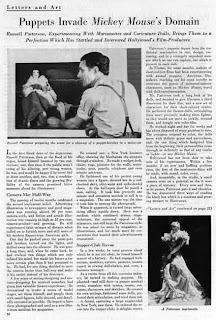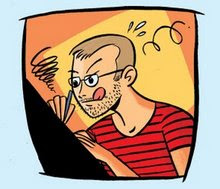Nowdays there seems to be more and more gradients used when coloring comics and comic book covers. Nothing wrong with that if done with a feeling for the tool and understanding of light and shadow and color in general. And if the artwork is created to work with a ton of gradients like some superhero comics are there is absolutely nothing wrong with it.
Good coloring is always about adding something to the image without distracting from it. It shall be there almost without being noticed. Like a good sundtrack to a movie.
But when I see a bad coloring job destroying a wonderful piece of artwork it's always a bit disappointing. And irritatiing because I know that it could have looked so much better.
Let me show you some examples.
(And I should add that I'm using some Disney comics as examples just because they clearly show my points and because I have them at hand in my studio. I'm not saying that these are the worst or best examples. It could just as well have been illustrated with Woody Woodpecker comics if I had any of those here. I'm using these images just to get my points across. )
This example comes from a Uncle Scrooge comics drawn by Daniel Branca. First I have isolated his black and white line art so you can see it the way he drew it.

Then we have the scandinavian coloring.

Just flat tones. The artists lines is speaking and the coloring is there like the soundtrack mentioned above. No indications of light more than the shadow beneath Scrooge. No distracting elements in the panel. We read the balloon and moves on to the next panel. Artwork, coloring and text in sync.
Then we have the US version of the same panel. Here every area has a gradient.

There is no focus and no reason. Just try to find the light source in the panel.
Branca drew a shadow but in this panel there seems to be one light source where the wall meet the floor, one beneath Scrooges beak and one above, one to the left thats shining on the object to the right etc.
There's just no afterthought or reason. The more gradients the better seems to have been the motto.
But sometime less is more I believe...
Our next panel from that story shows a bump. One version where the artwork tells the story and yet another where the color tries to add something unneccesary. (A green sky over a desert?)


Our third example is yet another idea about coloring and gradients. Thake a look at then second panel of the two.
Gradients and colors in the balloons??? The idea sounds bad and in my opinion it turned out bad too. Again: if there's no reason for a gradient why do it?


Next we have some covers. I've touched this subject before, see the post for March 3, 2008.
I have the same feelings for the two covers seen below as I have for the US Scrooge panels above. Looks like the colorist tries to add a "horizon" where the artist did none. (And I think the actual horizon line has been added to the Bolivar cover since there are versions without it.)
I believe that all of the covers below has been designed and drawn with the idea that the characters should stand out with one monochrome background color backing them up.


Compare the two first above with the two american covers below (drawn by Daan Jippes).


See how much clearer they are? The focus is on the gag and the artwork. Shadows has carefully been added to the areas where they are needed. A beautiful coloring job that I unfortunately have no idea who did.
The same goes for the cover below.

Just look at how carefully the shadows and highlights has been applied. This coloring job is also filled with different gradients and "shadow colors" but is the direct opposite of the Scrooge panels above. This colorist is aware of what he or she is doing and applies his/her skills to the artwork without destroying it. Instead the combination of the two becomes greater than the parts IMO.
Remember what I wrote in te beginning? "Good coloring is always about adding something to the image without distracting from it." And thats exactly what's done here and on the two MM and US covers above.
But maybe I'm totally wrong? Let me know your opinions!
To round off this post I just have one more cover for those of you who thinks gradients and horizons are neccesary to make a successful cover.

Nice, eh? ;)













































